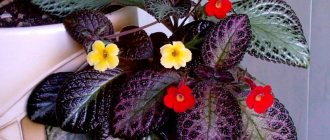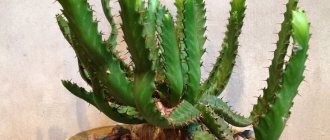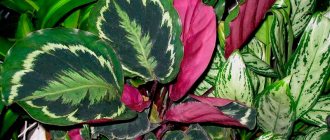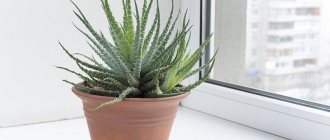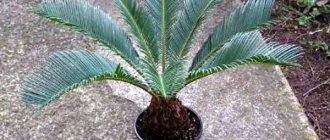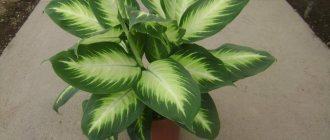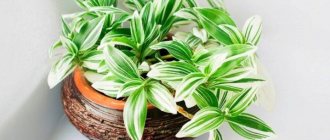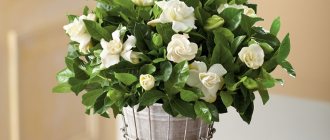The Schefflera plant belongs to the Araliaceae family. In the wild, it can be found anywhere in the world. Most often, this plant can be observed in Australia, China, the Pacific Islands and Japan. Uncultivated Schefflera is comparable to a short tree or bushy plant. This plant is loved by flower growers for its original, chic leaves, which in their shape resemble the palm of a person; they are like splayed fingers that do not touch each other.
The leaf blades are separated into several lobes (on average 4-12), grow from one point and are placed on a high petiole. In many countries, this plant is called: ombrelka for elves or ombrelka tree.
The raceme inflorescences of Schefflera resemble tentacles or antennae. Unfortunately, you can only see this miracle in a botanical garden, because at home it never throws out flower stalks. But it perfectly decorates a home or office thanks to its unique shape and chic foliage.
Amateur gardeners grow Schefflera, like ficus benjamina, as a huge indoor foliage tapeworm plant, forming it in the form of a shrub or tree, while it has a decent size.
The tall shoots of Schefflera have an average thickness, so very often several seedlings of the plant are planted in one pot at the same time. And only then, as they grow, they gradually form a single intertwined stem. If desired, you can plant one flower in a pot, but in this case you need to make a support for it.
Even inexperienced gardeners can grow this unique plant, because it is absolutely undemanding and unpretentious. It does not require special care; it requires just as much attention as other common potted pets.
Very important! Shefler contains toxic substances that, if they come into contact with the mucous membrane or skin, cause irritation. When performing various manipulations with the plant, precautions must be taken.
Rules for caring for shefflera at home
Schefflera is unpretentious when grown indoors. But there are simple maintenance rules that will ensure the beauty and long life of the plant.
Lighting
Since the sheflera needs diffused light, the best place in the apartment will be the window sills of the eastern and western windows. On northern windows you can place Schefflera species with single-colored green leaves. In summer, it is recommended to take the pot with the plant to the balcony or loggia, but be sure to shade it from direct sunlight and protect it from drafts. In autumn and winter, the flower needs additional artificial lighting, especially when the room temperature is above eighteen degrees.
Temperature
Although Schefflera comes from the tropics, it does not like high temperatures. In summer, the ideal temperature for her would be twenty degrees Celsius. If the weather is very hot, the flower may shed its leaves.
In winter, the optimal temperature is in the range from fourteen to eighteen degrees. If the plant remains in a room with central heating in winter, then it is necessary to protect it from the dry warm air of radiators.
How to water
Schefflera prefers moist soil without drying out or waterlogging. Therefore, special attention should be paid to the regularity of watering. In summer, watering is carried out approximately once every two days, after the top layer of soil has dried. But at the same time, you need to water moderately to prevent stagnation of water in the soil. Stagnation of water leads to rotting of the roots. For irrigation, use only settled water at room temperature so that the temperature of the soil in the pot is not lower than the air temperature.
Schefflera prefers high ambient humidity. You can place the pot with the plant on wet expanded clay. Spraying is carried out every two days in the summer. Water for spraying should also be settled and warm. When kept in a room in winter, they also continue to spray or wipe the leaves with a damp sponge.
Top dressing
Regular, timely feeding promotes the growth and health of sheflera. Liquid complex fertilizers for decorative deciduous indoor plants are suitable for it. From spring to late autumn, sheflera is fed twice a month. You can feed with organic and mineral fertilizers, alternating them.
Important! It is not recommended to feed the flower with dry fertilizers.
The soil
Schefflera prefers light, nutritious, slightly acidic soil. To prepare it yourself, you need to take the following components:
- leaf soil (30%);
- turf land (40%);
- humus (20%);
- sand (10%).
You can prepare a soil mixture from turf soil, humus and sand, taken in a ratio of 2:1:1. But it’s still easier to buy a ready-made substrate at a flower shop. For cheflera, a mixture for growing ficus and palm trees is suitable.
Transplant and pot
Schefflera is replanted in the first half of spring. Young seedlings are planted several in one pot. Choose a pot for shefflera that is stable and quite deep, so that the drainage layer is two to three centimeters. Expanded clay and crushed brick are used for drainage.
When replanting a young plant, which is carried out after two years, a little earthen mixture is poured onto the drainage layer. Lightly shake off the soil from the roots, transfer the flower to a new pot and sprinkle the roots with soil. The soil is compacted and watered abundantly.
The next time you replant, each new pot should be four to five centimeters wider than the previous one. Large plants are replanted using the transshipment method, without shaking off the soil from the roots. The older the flower, the less frequently it is replanted. This is done when the roots have completely filled the pot.
Shefflera crown formation
A special feature of shefflera is its negative reaction to pruning. Cutting off a large number of shoots greatly weakens the plant, and it begins to hurt. Therefore, gentle pruning can be carried out only when necessary.
A young, rapidly growing plant is pruned to form side shoots. Trim the top shoot into four internodes. The cut is made with a sharp pruner or knife, but not with scissors. The cut area is sprinkled with activated carbon. After a year or two, you can shorten the side shoots to give the bush a spherical shape.
The best way to get a lush bush is to plant several cuttings in one pot. Cuttings after pruning are used for rooting and obtaining new young plants.
How to transplant a shefflera. Tip 1: How to transplant a sheflera
Schefflera leaves are a unique and truly charming presentation. They simultaneously resemble a dill umbrella, a tropical butterfly, and an unprecedented peacock tail. Growing this plant at home is not that difficult; you just need to follow the care instructions. If you plan to transplant your green beauty, you also need to do this correctly.
- – “multifunctional” soil,
- - flowerpot,
- – water,
- – drainage.
Instructions
1. First, find out whether your cheflera needs a transplant. Shefflers replant young plants every year because they grow vigorously and quickly fill a small pot with their roots. Older plants, more closely formed, need to be replanted once every two to three years. If you still have any doubts, you can do the following: remove the shefflera from the pot and examine its root system. If you see that the roots are encircling the bottom and there is very little soil left, it’s time to replant. If there are only a few roots and the earthen lump is still loose, you can wait a little longer. 2. Start replanting by preparing the pot. Young sheflera plants are replanted with partial replacement of the earthen clod. Pour drainage and fresh soil into a larger pot so that after planting the plant, its roots do not protrude beyond the new pot. Carefully remove the shefflera from its dilapidated home, remove excess soil and replant. To ensure that the root system has a chance to grow in a new pot, plant the plant on a wide layer of soil, and not on drainage, lightly sprinkled with soil. After replanting, the plant must be pressed tightly so that no voids form in the pot, and the roots can adhere more closely to the ground and be watered generously. 3. Heavily large cheflers are replanted without replacing the soil ball. Easily remove the plant from the pot and transfer it to another, slightly larger one. Do not forget that there should be drainage in the pot in any case. Occasionally, if for some reason replacing the soil ball is unthinkable, it is appropriate to replace the top layer of soil. Carefully, so as not to damage the roots, remove the top layer of soil in the pot by about 10 cm and pour new fertile soil on top. Often, the top layer of soil in a pot cakes, making it difficult for moisture and air to circulate to the roots. Replacing this layer with a more loose and fertile one has a significant healing effect on the shefflera.
The plant is unpretentious and is often placed in office premises (a beautiful and neat tree or bush is in harmony with the work environment). But, nevertheless, it is important to know the basic rules of care and some features of the plant.
Watering
Like any tropical plant, it loves moderate watering as the top layer of soil dries out. In summer, the plant is watered once every 2-4 days, depending on the temperature and humidity of the environment, in winter - once every 10-12 days. Schefflera requires periodic spraying with soft, slightly cool water. You can place the container with the plant in a small tray with water or moistened moss. The plant will absorb the required amount of moisture through the drainage hole and leaves.
Top dressing
The plant needs a complex of vitamins and minerals, which will give it the opportunity to grow and develop. Feeding with any complex mineral fertilizer for decorative deciduous plants will help with this. Feeding is carried out through watering or spraying the leaves. In summer 2 times a month, in winter – 1 time.
Trimming
If you want to get a spherical version of the plant, you need to cut off the top at a height of 4-5 internodes with a sharp knife. The plant will gradually acquire the desired shape. To avoid causing harm, pruning is carried out in stages. If you want to grow a neat tree, do the same pruning of side shoots and leaves that stand out too much.
Transfer
If you purchased a young plant, it should be replanted once a year according to the method specified in paragraph 2. An adult plant is replanted every few years using the transshipment method if the soil is depleted and the bush has grown greatly. It is also necessary to replant the shefflera if the roots become visible through the drainage hole. This means the potty is too small for her.
Types of Schefflera for indoor breeding
Despite the variety of plant species, the decorative shefflera, which can be grown indoors, is represented by only four varieties and their varietal hybrids.
How to make a good summer pen for walking chickens with an aviary for 30 or 100 laying hens with your own hands? Photo
Radifolia (star-leaved)
The Schefflera radiata plant is quite large, growing more than two meters in height even at home. It has a straight, powerful brownish-gray trunk, thickened at the bottom, with large leaves on reddish-brown petioles.
They contain from five to sixteen fingers (depending on the age of the plant), having wavy edges of a bright green color and a length of ten to twenty centimeters. Particularly attractive is the Schefflera varietal hybrid Nora, whose leaf fingers are shaped like an oak leaf.
Eight leaf
Sheflera eight-leaved is characterized by a peculiar arrangement of leaf plates. On drooping cream-colored petioles, finger-like leaves up to forty centimeters long and ten centimeters wide, xiphoid in shape, are attached. There can be from six to twelve of them in umbrellas. At the beginning of growth they have an olive tint, then over time they acquire the usual light green color, the lower surface is matte. The veins of the foliage are somewhat lighter than the foliage itself.
Schefflera arborescens
Indoor plants of this type are small in height and compact in shape. Branches extend from the erect trunk, which are initially green in color, and with age it changes to light brown. The slightly pointed, glossy leaf blades are bright green in color and no more than twenty centimeters long. They are collected in umbrellas from seven to sixteen pieces each.
Of the varietal hybrids, the most popular among gardeners is the shade-loving Amati with numerous, beautiful, very large shiny green leaves, which are rarely affected by pests. Of the variegated forms of this species, Gold Capella is interesting, shaped like a palm tree with a green foliage surface, on which small yellow spots are scattered.
Palmate
Schefflera palmata is the smallest plant of this genus, grown indoors. Its small leaves number from seven to ten oblong lobes with pointed ends and veins that are brighter than the main surface.
Also very popular in indoor breeding are variegated forms of varietal hybrids with original green leaves, decorated with spots, streaks and strokes of white, cream and golden color. The most common ones include Gerda, Sofia, Louisiana, Arboricola, Bianca and Melanie.
general description
This plant is a member of the Araliaceae family. In nature, it is most often found in countries with hot climates and is distinguished by wide species diversity (about 400 species). The Schefflera plant got its name from the surname of Jacob Christian Scheffler, a Polish botanist who lived in the 18th century.
All types of this flower are represented by small trees or subshrubs and have an umbrella-shaped leaf structure. On a long petiole there are dissected lobes. Depending on the type of flower, there can be 4-12 lobes. The size and color of the leaves are also determined by species.
In nature, many varieties of this plant grow large. In some cases, their height can reach 6-8 m. For home breeding, more compact plants are chosen, the height of which does not exceed 1.2-1.5 m. However, even in such trees, growth can be controlled by forming the crown and pinching.
Shefflera propagation
Reproduction of Schefflera at home is not difficult. To do this, there are methods of cuttings, rooting cuttings or germinating seeds.
Propagation by cuttings
start rooting cuttings from the beginning of spring or summer . The cut of the future independent plant is carried out below the 3rd or 6th leaf diagonally on the semi-lignified stem.
Cuttings take root in moist peat or water, and it is better to remove the lower petioles. During the entire period of root formation, the temperature is maintained within 22...25 °C. Just like for an adult plant, direct sunlight on the cuttings is not allowed.
After about 2 weeks, roots will begin to appear on the cuttings, and with a length of 3–5 cm, the sprout can be planted in a separate pot with soil as for an adult flower.
In the process of propagating Schefflera by cuttings, all varietal characteristics of the mother plant are preserved.
View this post on Instagram
Posted by maya_mayskaya (@maya_mayskaya5) Nov 18, 2021 at 6:40 PST
Propagation by seeds
Seeds can only be purchased at a flower shop. It makes no sense to wait for seeds from a tree in the house, because Schefflera blooms extremely rarely in captivity .
Germination is carried out as follows:
- At the end of winter, planting material is soaked in a warm biostimulant solution.
- Prepare a mixture of peat and sand in equal parts, pour it with a pink solution of potassium permanganate to destroy harmful bacteria.
- Seeds are sown on the surface of the substrate, slightly buried by 0.5 cm.
- Water with warm water and cover with film.
- Air and soil temperatures are maintained at 20 to 24 °C.
- Daily for 15–30 minutes. open the film a little and monitor the humidity of the substrate.
Transplanting the sprouts is recommended after the formation of 3-4 leaves into a pot with a capacity of about 200 ml. The next shift is carried out after filling the entire earthen coma with roots.
The new plant does not always turn out the same as the mother plant or as indicated on the label. This is due to the large number of hybrid varieties, the seeds of which may show signs of the original species.
Reproduction by air layering
You can form a young sprout directly on an adult plant without cutting a cutting from it. To do this, the bark is cut to 2/3 of the circle on the trunk between the leaf axils. The damaged area is wrapped with moss soaked in Kornevin, and with film on top.
Over the next 1–2 months, the moss is constantly moistened. During this time, roots will appear - you can cut the sprout and plant it in a pot. This method of reproduction is only possible for a healthy shefflera over 5 years old.
Reproduction by shoots
This method of propagating shefflera is considered the most convenient and fastest. To do this, you can use cuttings cut during crown thinning. The choice of planting material must be approached extremely carefully. It is important to comply with a number of requirements:
- It is best to take cuttings from January to the end of March. Autumn pruning is also suitable, when the vegetative activity of the plant is completed.
- Suitable for planting are shoots cut from the middle part of the stem.
- The length of the cutting should be 10-20 cm.
- The leaves located in the lower part of the shoot are removed. It is recommended to leave only 3-4 leaves at the top.
- Only healthy, strong cuttings are suitable for rooting.
The cut is made only with a sharp knife or pruning shears. The crop can be germinated in water or immediately placed in the ground.
If germination occurs in water, then add soft water at room temperature into a glass. You can add a small amount of ash to the container. This composition will prevent rotting of the cuttings. As soon as the shoot has roots (this takes 2-3 weeks), it can be transplanted into the ground.
If the cutting is placed directly into the soil for rooting, then the shoot is deepened into the soil by about 1 cm. After planting, the soil should always be kept moist. Cover the pot with film and ventilate it periodically.
Useful properties of shefflera
Schefflera improves the environmental conditions of the room in which it grows: it increases air humidity and saturates it with air ions and ozone, and removes benzene.
The umbrella tree contains toxic substances that irritate the skin and mucous membranes. Therefore, it is better to keep it away from small children and pets, and after contact with the plant, wash your hands thoroughly.
Reproduction by air layering
To propagate Schefflera in this way, you will need a piece of moss. At a short distance from the top of the flower, an incision is made on the trunk. This place is covered with moss and moistened periodically. The moss should not dry out. After 7-8 weeks, roots will form at the site of the cut.
After this, the top of the plant with roots is cut off and rooted in a pre-prepared pot with moistened soil. After the new plant is accepted in a separate container, you can care for it as usual.
Description of Schefflera flower
The plant is distributed in the tropics and subtropics, in South and Southeast Asia. Under natural conditions, it can reach a height of more than 15 meters, and at home, the graceful sheflera Melanie does not exceed 50 cm.
Schefflera tree in nature
The flowering plant looks very beautiful; it throws out a fountain of reddish flowers at the top. Of course, you can admire this spectacle either in Schefflera’s homeland or in the picture, since it does not bloom at home.
Shefflera has beautiful dissected leaves. They look especially impressive with more than twelve leaf plates. The leaf can be simple, smooth, wavy or with a jagged edge. The color of the leaf can be light green, deep dark, variegated.
Kinds
There are about 400 species of shefflera in nature, but only a few of them are used for keeping in apartments:
- Radiant (the second name is star-leaved). This variety can be recognized by its 16 leaf lobes, which radiate from the center like rays. Each leaf blade has an elongated shape with a blunt end. The leaves can reach 15 cm in length and 5 cm in width. The bright green surface is leathery and glossy. The veins can be either green or golden.
- Eight-leaved. This variety of indoor flower Schefflera has become widespread among flower growers. The leaves of this plant consist of 8 lobes and reach a length of 30-40 cm. The leaf blade is characterized by a lanceolate shape with a slight point at the top. The surface of the sheet is dense matte. The color can be either darker or bright green.
- Janine. This variety is rightfully considered one of the most beautiful. It is distinguished by the variegated colors of the leaves and their uneven edges. Each rosette is painted in a rich green color, smoothly flowing into yellow and white spots.
- Palmate. The natural habitat of such shefflera is New Zealand. Some specimens can reach a height of 8 m. The palmate variety has a visual resemblance to the radiate variety. On long petioles (up to 20 cm long) there are 8 ellipsoidal leaves. The average length of each leaf blade reaches 15 cm, but large representatives have leaves of about 30 cm.
- Bianca. The originality of this flower lies in its thick crown and carved leaf plates. Each leaf grows up to 10 cm in length and is dark green in color. At the same time, there is a yellowish edging at the base and along the edges of the sheet.
- Louisiana. This shefflera variety wins the hearts of even experienced gardeners. The bright green leaves are oval, slightly elongated, and do not have a pointed end. Their surface is dense, glossy. In bright light, yellowish spots appear on the leaves, which increases the attractiveness of the flower.
Caster. This shefflera variety is ideal for growing in apartment conditions. The plant reaches a height of no more than 120 cm. The dense, leathery leaves are colored a deep shade of green.
Watering
The plant should be watered moderately and the soil should be slightly moist. It is extremely undesirable for the soil to be too dry, but Schefflera arborescens can withstand this, but overmoistening can result in blackened and fallen leaves.
House Plant Magazine || Menu || Category: Care and reproduction || Maranta tricolor home care || Caring for dracaena at home || Zamioculcas zamifolia. Basic methods of reproduction || Transplanting and propagating dracaena at home || Caring for the beautiful Calathea
Water for irrigation should be soft and settled, otherwise white spots will remain on the leaves. In hot weather, the space around the plant should be sprayed with a fine spray bottle. When dust accumulates on the leaves, they should be wiped with a damp cloth.
Propagation by seeds
This method of propagating shefflera is not often used. This is due to the large time costs. It is best to sow seeds in early spring. The whole process can be divided into several stages:
- Soil preparation. A mixture of sand and peat works well for this. Another soil option is sand, leaf and turf soil mixed in equal proportions. Before sowing, the soil must be treated with a disinfectant composition.
- When sowing, the seeds are lightly sprinkled with soil. They should not be deepened too much, as this makes germination difficult.
- The soil is moistened with a spray bottle and covered with film.
- The box with seeds should be kept in a warm, bright place until the leaves peck.
After 2-3 leaves appear on each sprout, the seedlings are picked and transplanted into pots.
Lighting and temperature
The plant loves fairly good lighting. East and west windows would be ideal for it. It is possible to grow Schefflera arborescens in a north window.
However, it is better not to choose the north side for variegated varieties, otherwise the pattern will lose its brightness and expression.
Schefflera arborescens grows well in air-conditioned rooms and well-ventilated areas. However, you should not place the plant under cold streams of air.
Despite the fact that the plant comes from warm countries, a south window is not suitable for it. On particularly hot days, burns may appear on the leaves. However, if there is no other place for the plant, you can place it on a table next to a south window.
A location in the shade , in the back of the room, is not suitable, because in such conditions, Schefflera arborescens may wither. The ideal temperature for Schefflera tree is +17+22°C. This temperature may vary slightly.
Selecting optimal conditions and temperature conditions
If you don’t want to wonder why the cheflera isn’t growing, you just need to remember a few simple rules. Create such a habitat so that the cheflera flower feels more than comfortable. The best place for it will be sills facing west and east. If this is not possible, it will be enough to place it right next to the window, so that diffused sunlight falls on the flowerpot. It must be remembered that this delicate plant should avoid drafts . It is also an excellent condition that your home or office space has air conditioning. This will give a chance to make the optimal temperature in the room 18-22 degrees Celsius and at the same time the flower will grow much better and faster. But if there is no air conditioning in the room, you should know that then the flower needs to be additionally watered and sprayed with water.
Top dressing
Schefflera does not produce flowers indoors, so fertilizing begins when new leaves begin to appear in the spring. It is enough to feed the flower once every 15 days with any fertilizer for decorative flowers, slightly reducing the recommended dosage.
Crown formation
In order for the shefflera to please the eye with a lush crown, it is necessary to properly trim the shoots and monitor new growth. The apical shoot of a young plant is cut off with sharp scissors, shortening it by 4 internodes. Then the plant will not stretch upward, but will begin to produce side shoots, which also require timely pruning. The cut areas must be treated with crushed coal.
Attention! The juice of the plant is poisonous, so precautions should be taken to avoid getting the juice on the mucous membranes.
Crown formation
Pruning shefflera must be done extremely carefully, since this procedure negatively affects the condition of the flower - the growth of the plant stops. After removing a large number of shoots, this representative of the flora may be sick for a long time and shed its leaves.
Young plants that quickly grow upward need pruning first. To slow down this process and activate the appearance of side shoots, the top is pinched at 4 internodes.
Use pruning shears or a sharp knife to perform pruning. This reduces damage to the trunk and speeds up the recovery process. The cut of the shoot should be sprinkled with activated carbon.
The side branches can be pinch off after 2-3 years. Thanks to this, the crown acquires a rounded beautiful shape.
Pests
The most common pests that appear on tropical households are scale insects, aphids and spider mites . All of them are manifested by yellowing and falling leaves, as they feed on their sap, as well as visible small insects on the surface.
At the onset of infection, mechanical removal of pests using cotton wool and a solution of soap and alcohol is effective .
If after a few days insects are again noticeable on the plant, then spraying with insecticidal preparations for plants (Aktara, Fitoverm) is necessary. The frequency of treatment depends on the type of pest and is usually indicated on the label.
Sheflera transplant
Young chefleras need to be replanted every year in the spring, older ones - as the entire pot is filled with the root system (every few years). You should not replant the plant immediately into a very large pot; you need to increase its size gradually. Each subsequent pot for replanting should be no more than 6-8 cm larger than the previous one.
Schefflera is considered a mildly poisonous plant, so when working with it it is important to use gloves as a means of protection.
To make sure that replanting is necessary, you need to carefully remove the plant from the pot and assess the condition of the roots. If it’s time to replant the flower, you must immediately prepare a pot, drainage (pebbles or expanded clay), a suitable substrate and settled water at room temperature
To replant, remove the plant from the pot and carefully remove some soil from the roots. There is no need to remove too much soil or try to shake the ground - this can seriously damage the root system of the sheflera. A layer of drainage and a little new substrate are poured into the new pot. Then the plant is placed in a pot, sprinkled with new soil and watered.
For young and fragile plants, the transshipment method is often used. It is more gentle compared to transplantation and eliminates injury to the plant
The essence of this method is not to disturb the earthen ball, but to carefully “dump” it into a new pot with drainage, and then fill the remaining space in the pot with new soil. You can also combine several young plants into one pot for a more spectacular and lush look.
If replanting is impossible for one reason or another, then you should simply replace the top depleted layer of soil with a new one.
Schefflera diseases
Many people wonder what to do if the leaves of the sheflera fall off? The plant, despite its unpretentiousness, reacts negatively to high and low temperatures, sudden temperature changes, waterlogging and drafts, and lack of light. The reaction to many external stimuli in a tropical flower is the same - the shefflera sheds its leaves. Therefore, it is necessary to carefully analyze the conditions of detention in order to determine and eliminate the cause of leaf fall. When conditions improve, the plant stops shedding leaves, and over time its decorative appearance will be restored.
It is more difficult to cope with root rot, which occurs with frequent waterlogging and keeping at low temperatures. Rot is manifested not only by the withering and falling of leaves, but also by the appearance of black spots on them. If such symptoms of the disease occur, remove the plant from the pot and check the condition of the roots. Damaged, diseased roots are removed. Then the root system is immersed in a weak solution of potassium permanganate for twenty minutes to disinfect, and then planted in a new pot and new soil. The old pot must be disinfected before reuse.
- Excessive watering can be manifested by the appearance of small bubbles on the underside of the leaf blade. This disease is called "dropsy".
- Direct sunlight can cause yellow spots to appear on the leaves. With a lack of light, the leaves turn pale, especially variegated varieties lose their decorative effect.
- The tips of the leaves turn brown and dry out if there is insufficient watering or low ambient humidity.
Diseases and pests of Schefflera
This flower from the Araliaceae family adapts well to the environment and does not require care. However, if watering or lighting is incorrect, the plant begins to hurt. If measures are not taken, the shefflera will die.
Experienced flower growers give some tips on how to restore flower health:
- Withering of the flower and dropping of the foliage. Many beginners wonder why Schefflera leaves fall off? In most cases, the cause of this phenomenon is improper watering. Excess moisture provokes rotting of the root system. The flower begins to hurt. Correcting watering will restore the health of the plant.
- Wilting and yellowing of leaves. One possible cause is exposure to the sun, which results in burns.
- Spots on Schefflera leaves. Often the appearance of brown spots on the trunk and leaves indicates hypothermia and exposure to drafts.
- Schefflera turns yellow. In most cases, the appearance of yellow leaves and their wilting indicates insufficient watering.
To restore the plant, it is necessary to identify errors in care and eliminate them. To speed up the appearance of new leaves, experts recommend adding Zykron to the water for irrigation. 1 drop of product per glass of water is enough. For spraying, you can use water with the addition of Epin. 2 drops of the composition are diluted in 200 ml of water.
This plant is often attacked by harmful insects. Among them:
- aphid;
- scale insect;
- mealyworm;
- spider mite
To get rid of insects, you need to use a solution of karbofos or other chemicals for pest control.
Powdery mildew is another disease that causes plant death. The presence of this disease can be determined by the appearance of a white coating on the leaves. You can get rid of powdery mildew by spraying with Bordeaux mixture (1%). The procedure must be repeated once every 10 days.
Benefits and harms
"Schefflera arborescens" is a mildly poisonous plant. However, it is unlikely to cause harm to an adult. As a safety precaution, you can wash your hands after trimming the plant and avoid getting its sap in your eyes.
At the first signs of poisoning (vomiting, diarrhea, restlessness), it is necessary to take your pet to a veterinarian.
In a well-lit, spacious room, "Schefflera Tree" quickly grows into a beautiful tall plant. It’s worth paying a little attention to it to protect it from drought and pests, and the open palms of the leaves will delight the eye with their bright glossy green all year round.
Features of care at different times
It has been noted that the Schefflera flower is able to adapt to room conditions and easily tolerates even low humidity.
On the other hand, in different seasons it is advisable to follow certain maintenance rules that will allow you to grow a fragrant and healthy bush of this exotic plant.
in spring
So, in early spring it is customary to feed the flower. At first, it is better to give preference to mineral fertilizers rich in phosphorus and potassium.
As summer approaches, you can gradually include organic fertilizers in your fertilizing.
The peculiarity of Scheffler is that he really loves feeding. For this reason, it is not enough for him to apply fertilizer only once a season. Throughout the warm season, right up to the autumn cold, you should alternate different products: first mineral, then organic. Optimal frequency of feeding: once every 2-3 weeks.
In summer
During the summer months, the most dangerous thing for Scheffler is the heat. Therefore, during non-summer, special care should be taken to ensure that the flower is not in direct sunlight. In fact, he will have enough light even at a distance from the window.
The optimal temperature for Scheffler is no more than +22-23С. Even a few extra degrees plus is already perceived negatively by the plant.
By the way! During the warm season, the flower can be taken out to the balcony or left in the garden outdoors, if conditions permit. The only thing you need to make sure is that the plant does not get a lot of sunlight and is not disturbed by strong drafts.
In summer, it is also important to water the soil at least once every 1-2 days. As an additional measure, spraying the leaves with a spray bottle is suitable: the more often, the better.
You can also start propagating Schefflera, especially if the bushes grow a lot.
in autumn
The closer the onset of winter, the less often you should water the flower. If the autumn turns out to be warm, then it is enough to water the flower no more than 2 times a week. If the cold comes quickly, then 1 watering per week will be enough for Schefflera.
The amount of fertilizing should also be gradually reduced to a minimum. It’s definitely not worth fertilizing the soil in late autumn.
If a pot with a flower was taken outside for the summer, then at the very beginning of autumn it must be returned indoors, since in the evening and night hours it will already begin to freeze.
in winter
Winter is a dormant time for most plants. Schefflera's flower is no exception. He likes to wait for spring in a cool room. A good temperature for it is considered to be the range from +14С to +16С.
Obviously, in winter you should not water the flower often. This should be done as needed, avoiding the appearance of dampness (this is the first step to preventing the appearance of diseases and pests).
Another important point is the lack of light in most regions of Russia during winter. Perhaps the Schefflera flower will need to be additionally illuminated (even ordinary office or room lighting can handle this). Otherwise, the flower may wither and die, not to mention normal development and flowering.
